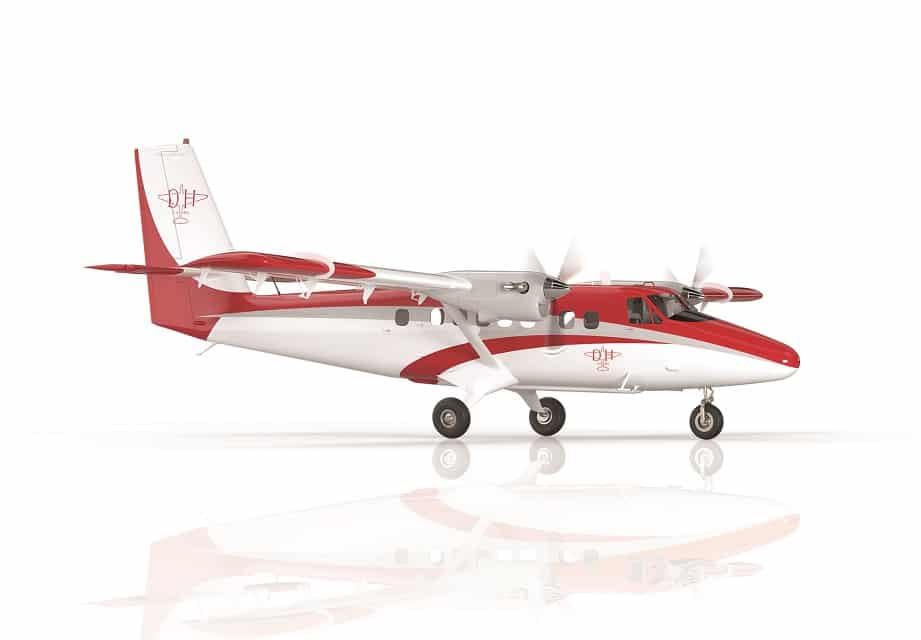Aerospace
De Havilland Canada launches the DHC-6 Twin Otter Classic 300-G

PARIS, France and CALGARY, Alberta, June 19, 2023 – Today, at the Paris International Air Show, De Havilland Aircraft of Canada Limited (De Havilland Canada) announced the launch of the DHC-6 Twin Otter® Classic 300-G™ with combined purchase agreements and letters of intent totaling 45 aircraft.
“For over 50 years, the DHC-6 Twin Otter has stood alone as the most reliable and versatile aircraft in its class,” said Brian Chafe, CEO of De Havilland Canada. “After extensive consultation with our customers, we are poised and proud to take this iconic aircraft to new heights with the new DHC-6 Twin Otter Classic 300-G.”
“With the same rugged airframe, propelled by Pratt & Whitney technology, the lighter weight Classic 300-G will deliver increased payload range and decreased operating costs for our customers,” added Chafe. “Along with an all-new cabin interior and flight deck featuring the Garmin G1000® NXi fully integrated avionics suite, De Havilland Canada is once again driving the utility transport aircraft market forward.”
“De Havilland Canada continues to shape aviation with innovative utility aircraft, and we are proud to offer our G1000 NXi integrated flight deck with the latest version of the iconic DHC-6 Twin Otter,” said Carl Wolf, Garmin Vice President of Aviation Sales and Marketing. “The G1000 NXi will bring wireless cockpit connectivity, enhanced situational awareness, visual approach capability, and our fully integrated GFC™ 700 autopilot with envelope protection to the Classic 300-G aircraft.”
New Hong Kong firm Fly Meta to take converted 777-300ER freighters(Opens in a new browser tab)
Over the course of the Paris International Air Show, De Havilland Canada will announce Purchase Agreements with our valued Twin Otter Classic 300-G launch customers.
The Classic 300-G is the fifth generation of the Twin Otter aircraft, joining the current Series 400. All DHC-6 Twin Otters carry passengers, transport VIPs, move cargo, conduct medivac operations, and perform special missions in the world’s most unforgiving environments. When mounted on amphibious floats, these aircraft move seamlessly between paved surfaces and water-landing areas.
New Hong Kong firm Fly Meta to take converted 777-300ER freighters(Opens in a new browser tab)
As De Havilland Canada continues to grow its footprint in Canadian aerospace, the launch of the DHC-6 Twin Otter Classic 300-G will bolster the local economy by creating 80 and 91 permanent production jobs in Calgary, Alberta and Victoria, British Columbia, respectively.

Aerospace
Boeing Transfers Rocket Stage to NASA, Paving Way for Human Moon Mission

Boeing has achieved a significant milestone by providing NASA with the second core stage of the Space Launch System (SLS) rocket.
This crucial component, crafted at NASA’s Michoud Assembly Facility (MAF), is set to propel the Artemis II crew into lunar orbit, marking humanity’s return to deep space after a 50-year hiatus.
The monumental Boeing-built rocket stage, the largest element of the Artemis II mission, will embark on a journey aboard the Pegasus barge, traveling 900 miles to NASA’s Kennedy Space Center.
Comparison of two legendary aircraft B777x vs B747 aircraft:Click here
Upon arrival, it will be meticulously integrated with other essential Artemis II components, including the upper stage, solid rocket boosters, and NASA’s Orion spacecraft within the iconic Vehicle Assembly Building. This intricate integration process is a vital step toward the eagerly anticipated Artemis II launch, slated for 2025.
“Boeing-built products helped land humankind on the moon in 1969, and we’re proud to continue that legacy through the Artemis generation,” remarked Dave Dutcher, vice president and program manager for Boeing’s SLS program. “Together, with NASA and our industry partners and suppliers, we are building the world’s most capable rocket and paving the way to deep space through America’s rocket factory in New Orleans.”
NASA, Lockheed Martin Reveal X-59 Quiet Supersonic Aircraft:Click here
The delivery of Core Stage 2 marks a significant achievement in the evolution of the SLS rocket. Towering over 200 feet and powered by four RS-25 engines, this core stage, coupled with two solid-fueled booster rockets, will generate a staggering 8.8 million pounds of thrust. This immense power is crucial to launching Artemis II and future missions into the vast expanse of space.
The SLS rocket stands unparalleled in its capability to transport both crew and substantial cargo to the moon and beyond in a single launch. Its extraordinary capacity will facilitate the delivery of human-rated spacecraft, habitats, and scientific missions to destinations including the moon and Mars, ushering in a new era of space exploration.
-

 Travel1 week ago
Travel1 week agoAir India to Expand US Operations with Three New Routes After a Decade
-

 Travel2 weeks ago
Travel2 weeks agoWhy We Should Avoid These Stamps in a Passport
-

 Airlines1 month ago
Airlines1 month agoInvestigations Reveal Fake Chinese Titanium in Boeing and Airbus Jets
-

 Tech4 weeks ago
Tech4 weeks agoChina’s CATL Plans 1,800-Mile Electric Plane Launch by 2027
-

 Airport3 days ago
Airport3 days agoTop 10 Largest Airports in the World by Size
-

 Aerospace4 weeks ago
Aerospace4 weeks agoChina’s Fighter Jets Turn Wings into Autonomous Drones
-

 Airlines4 days ago
Airlines4 days agoAir India Rolls Out A350s for Delhi-New York JFK and Newark Routes
-

 Defence3 weeks ago
Defence3 weeks agoBoeing Enhances Chinook with New Engines and Block II Upgrades at $96 Million







